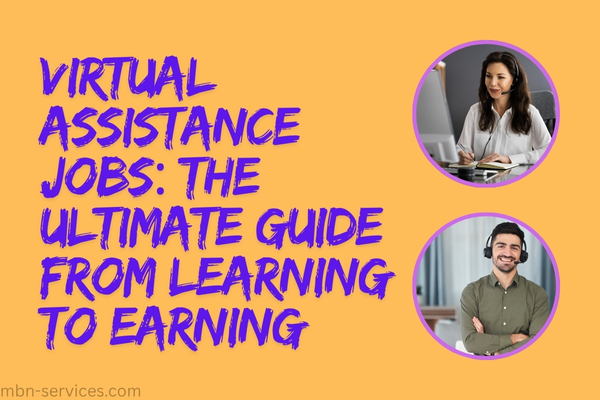Table of Contents
Virtual assistance jobs have become one of the most flexible, in-demand, and beginner-friendly career paths in today’s remote-first world. Whether you’re looking to escape your 9–5, work from home, or earn on your own terms—this guide has everything you need to know.
From learning the basics to landing your first client, we’ll walk you through the exact steps to start earning online as a virtual assistant.
What Is Virtual Assistance?

Virtual Assistance Jobs involve providing professional support services to businesses, entrepreneurs, or executives—completely remotely. As a Virtual Assistant (VA), you operate as a contractor or freelancer, taking on administrative, technical, or creative tasks that clients either don’t have time for or don’t want to do themselves.
Real-World Examples of Virtual Assistance Work:
- For a busy real estate agent: You might manage their calendar, respond to listing inquiries, and update MLS entries.
- For an e-commerce store: You could handle product data entry, order processing, or responding to customer questions.
- For a content creator: You might schedule social media posts, upload YouTube videos, or handle email marketing.
Whether it’s handling emails, managing spreadsheets, organizing schedules, or updating websites, Virtual Assistance Jobs can cover a wide scope of responsibilities. What sets them apart is flexibility: both in tasks and work hours.
Types of Clients Who Hire VAs:
- Startups looking to reduce full-time staffing costs
- Coaches & consultants who need help with bookings and CRM tools
- Busy professionals who want administrative help without hiring in-house
- Small businesses trying to streamline operations affordably
Work-from-Anywhere Career
Since tasks are performed online, you can live anywhere in the world and still deliver high-value results. That’s why Virtual Assistance Jobs are becoming one of the most accessible online careers for beginners and seasoned professionals alike.
Why Virtual Assistance Jobs Are in High Demand
The demand for Virtual Assistance Jobs has grown dramatically in recent years, driven by the global shift toward remote work and digital business operations. As more startups, entrepreneurs, and even large corporations move online, the need for cost-effective, flexible support staff has skyrocketed.
According to Upwork’s 2023 Freelance Forward report, over 60 million Americans freelanced that year, and virtual assistants were consistently ranked among the top five most in-demand freelance roles. This trend is not limited to the U.S.—businesses worldwide are now leveraging virtual assistants to streamline operations and cut costs.
Benefits for Businesses
- Reduced Overhead Costs: Hiring a virtual assistant means businesses can avoid expenses related to office space, equipment, and employee benefits.
- Scalable Workforce: VAs offer flexible work arrangements, making it easy to scale up or down based on workload without long-term contracts.
- Access to Global Talent: Businesses can hire skilled professionals from any country, allowing them to tap into a wide talent pool at competitive rates.
- Increased Efficiency: Delegating repetitive tasks to VAs frees up time for core business activities, leading to better productivity and faster growth.
Benefits for Freelancers
- Location Independence: Virtual assistants can work from anywhere in the world, as long as they have a stable internet connection.
- Flexible Scheduling: Freelancers can choose clients based on preferred working hours and availability, which supports work-life balance.
- Diverse Opportunities: From customer service and scheduling to marketing and content creation, VAs can work across various industries and roles.
- Income Growth Potential: With the right skills and client relationships, virtual assistants can steadily increase their hourly rates or transition to running their own VA agencies.
Top Skills Required for Virtual Assistance Jobs
You don’t need a university degree to become a successful virtual assistant (VA), but you do need a well-balanced combination of soft and hard skills. These competencies determine your effectiveness, credibility, and earning potential in the remote job market.
Soft Skills
- Clear Communication
Virtual assistants must communicate professionally with clients, often across different time zones. This includes writing concise emails, managing chats, and speaking confidently on calls. - Time Management
Efficiently juggling multiple tasks and clients is a core responsibility. VAs must meet deadlines consistently, prioritize tasks, and use tools to track their time effectively. - Problem-Solving
Whether it’s finding a faster tool or resolving a scheduling conflict, clients appreciate VAs who can troubleshoot independently without requiring constant guidance. - Confidentiality and Trustworthiness
Many VAs handle private business information, customer records, or login credentials. Maintaining confidentiality is not just a skill—it’s a professional expectation. - Self-Motivation and Discipline
Since virtual assistants work remotely, they must be able to stay focused, organized, and productive without supervision.
Hard Skills
- Google Workspace (Docs, Sheets, Gmail)
VAs frequently collaborate via cloud-based tools. Proficiency in Google’s suite is essential for document creation, spreadsheet management, and client communication. - Canva
Basic design skills using Canva allow VAs to create polished social media posts, blog banners, presentations, or promotional graphics. - Project Management Tools (Trello, Asana, ClickUp)
Knowing how to manage workflows and timelines using tools like Trello or Asana helps with task tracking and improves client satisfaction. - Video Conferencing (Zoom, Skype)
Comfort with video calls, screen sharing, and virtual presentations is essential, especially when onboarding new clients or joining team meetings. - Microsoft Office (Word, Excel, PowerPoint)
Many clients still prefer Office tools for documents, spreadsheets, and presentations, so these are must-have proficiencies.
Bonus and Specialized Skills
- Multilingual Communication
Fluency in more than one language opens the door to international clients and higher-paying roles involving translation or bilingual customer service. - CRM Systems (HubSpot, Salesforce)
Familiarity with customer relationship management tools helps you assist with client onboarding, lead tracking, and sales support tasks. - Basic SEO Knowledge
Understanding search engine optimization enables you to support blogging, content marketing, and website optimization tasks—especially valuable for digital marketing clients.
Best Platforms to Find Virtual Assistance Jobs
Getting hired as a virtual assistant starts with knowing where to look. Below are the top types of platforms that consistently provide remote opportunities for VAs at every experience level:
Freelance Marketplaces
Fiverr
Fiverr allows you to create service listings (“gigs”) based on your skills. It’s ideal for beginners who want to test the waters or work part-time. You set your own prices, and clients purchase your services directly.
Upwork
Upwork is one of the largest freelance job platforms. You can submit proposals for both one-off tasks and long-term contracts. Building a strong profile and earning good reviews can lead to recurring work and higher pay.
Freelancer.com
This bidding platform lists thousands of new jobs daily. You can browse categories like data entry, customer service, and admin support. It’s especially useful if you want to explore diverse VA tasks across industries.
Remote Job Boards
Remote.co
A trusted site dedicated exclusively to remote jobs. Virtual assistant listings range from entry-level to executive support roles, often with flexible hours and international companies.
Website: https://remote.co
We Work Remotely
Known for its high-quality job postings, this board includes VA roles from startups, agencies, and tech companies. Listings often come from companies looking for long-term help.
Website: https://weworkremotely.com
Virtual Vocations
This platform specializes in remote and telecommuting jobs, including VA roles. It screens listings for legitimacy and often offers filters for part-time, full-time, and contract-based jobs.
Website: https://www.virtualvocations.com
Agency-Based Platforms
Belay
Belay recruits experienced virtual assistants to support executives, nonprofits, and entrepreneurs. The selection process is rigorous, but pay is often higher and consistent.
Website: https://belaysolutions.com
Boldly
This premium staffing agency offers long-term remote positions for VAs who can commit 20+ hours per week. Their clients often include Fortune 500 companies.
Website: https://boldly.com
Time Etc
This platform connects virtual assistants with entrepreneurs and small businesses. It’s known for flexible hours and varied work, making it ideal for freelancers who want steady part-time tasks.
Website: https://web.timeetc.com
Step-by-Step: How to Start a Career in Virtual Assistance
Starting a virtual assistant career is more accessible than ever, but it helps to follow a clear roadmap. Here’s a beginner-friendly guide:
Step 1: Learn the Basics
Build foundational knowledge by taking beginner courses in virtual assistance, digital tools, and remote communication.
Recommended platforms:
- Coursera: Offers courses from institutions like Google and the University of Illinois.
- Udemy: Search for “Virtual Assistant” or “Remote Work” skills.
- HubSpot Academy: Free courses on productivity, CRM tools, and customer service.
Step 2: Choose a Niche
General VAs are common, but specialists earn more and attract better clients. Identify your interests and skills, then choose a niche.
Popular niches include:
- Social Media Management
- Executive Assistance
- E-commerce Support (e.g., Shopify, Amazon)
- Real Estate Virtual Assistance
- Tech Support or IT Helpdesk
Step 3: Build a Service Portfolio
You don’t need client experience to create a portfolio—mock projects work.
Tools to use:
- Canva: Create branded visuals and sample social media posts.
- Google Docs: Write sample reports, emails, or SOPs.
- Notion or Wix: Build a free website or digital portfolio to showcase your work.
Step 4: Set Up Freelance & Professional Profiles
Build profiles that reflect your niche, personality, and professionalism. Use a clear headshot and write a compelling bio.
Essential platforms:
Step 5: Apply Strategically & Consistently
Craft personalized proposals for each job. Focus on how your skills solve a client’s problems.
Tips:
- Reuse and tweak templates to save time.
- Track your applications using a spreadsheet.
- Join VA Facebook groups or Slack communities—many gigs are shared informally.
Earning Potential in Virtual Assistance Jobs
Income as a virtual assistant varies widely based on your experience level, niche, and the quality of your client relationships. As you build your skills and specialize, your rates can increase significantly.
Typical Hourly Rates
- Beginner VAs: $5–$15/hour
- Intermediate VAs: $15–$30/hour
- Expert or Niche VAs: $30–$75/hour
Platform-Based Earnings
- On Fiverr, many part-time virtual assistants earn between $500 and $2,000 per month, depending on gig volume and client reviews.
- On Upwork, Top-Rated freelancers often charge $20–$50/hour, with consistent bookings and repeat clients.
Source: Fiverr Business Blog, Upwork Freelance Forward 2023 Report
Tips to Stand Out and Succeed
- Niche down to reduce competition
Focusing on a specific area, like social media management or real estate support, helps you become an expert clients trust instead of a generalist lost in the crowd. - Craft irresistible gig descriptions and proposals
Write clear, benefit-focused descriptions that show exactly how you solve clients’ problems. Tailor each proposal to the job to grab attention. - Always respond quickly and professionally
Fast, polite replies build trust and show clients you’re reliable—an essential trait for virtual assistants. - Ask happy clients for reviews
Positive feedback boosts your profile and helps attract more clients. Don’t be shy about requesting reviews after successful projects. - Keep learning new tools (AI tools, CRM systems, automation apps)
Staying updated with popular software makes you more efficient and valuable, helping you offer better support and stand out in a competitive market.
Tools Every Virtual Assistant Should Know
Task & Project Management:
- Trello: A simple, visual tool using boards and cards to keep track of your tasks and deadlines. Great for organizing daily work.
- Asana: More advanced, allowing team collaboration with timelines, task dependencies, and project tracking.
- ClickUp: Combines project management with docs and goals, perfect if you want an all-in-one productivity platform.
Communication & Meetings:
- Slack: Popular chat app for real-time messaging, file sharing, and quick team communication.
- Zoom: Reliable video conferencing tool widely used for virtual meetings and webinars.
- Skype: An easy-to-use video call and messaging platform, still favored for client calls.
Productivity:
- Google Docs: Cloud-based document editor that allows you and clients to collaborate on files in real time.
- Dropbox: Secure cloud storage for sharing and organizing files easily.
- LastPass: A password manager that lets you securely share passwords with clients without risking security.
❌ Myths vs. ✅ Facts: Virtual Assistance Jobs

- Myth: It’s only data entry work.
✅ Fact: VAs handle everything from project coordination to graphic design. - Myth: You must be tech-savvy to start.
✅ Fact: Many tasks only require basic computer and internet skills. - Myth: You need a formal degree.
✅ Fact: Experience, reliability, and skills matter more than degrees. - Myth: You won’t make real money.
✅ Fact: Many VAs earn full-time incomes and even start agencies. - Myth: It’s not a long-term career.
✅ Fact: With specialization and scaling, it can be a lifelong business.
FAQs about Virtual Assistance Jobs

1. How do I become a virtual assistant with no experience?
Start by learning the basics, build a portfolio with sample work, and join beginner-friendly platforms like Fiverr or Remote.co.
2. Is virtual assistance a good full-time career?
Yes! Many VAs make full-time incomes, especially after gaining skills and building a client base.
3. How much do beginner virtual assistants earn?
Beginners typically start around $5–$10/hour, but rates increase quickly with skill and experience.
4. Can I work part-time as a virtual assistant?
Absolutely. Many VAs work evenings or weekends and still earn a decent income.
5. What qualifications do I need?
You don’t need a degree—just strong communication, basic tech skills, and a willingness to learn.
Conclusion: Ready to Start Your Virtual Assistant Journey?
Virtual assistance jobs are a golden opportunity for anyone looking to work remotely, earn flexibly, and build an independent career.
If you’re looking to boost your skills before jumping in, check out:
🔗 20 Easy Freelancing Skills for Beginners to Learn Easily
And if you’re in India, can speak Hindi, and want to earn using just your mobile phone, you can explore this beginner-friendly opportunity here:
🔗 Earn Online from Your Mobile


1 thought on “Virtual Assistance Jobs: The Ultimate Guide from Learning to Earning”